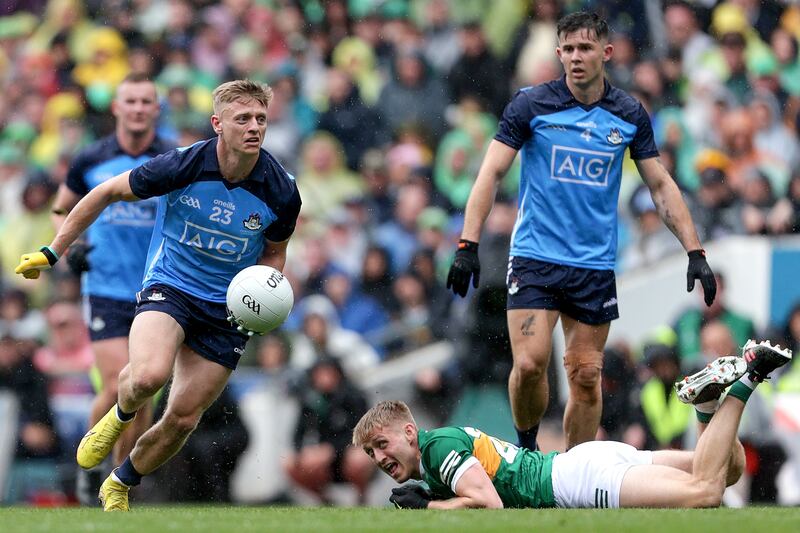The original impulse to codify rules for Gaelic football had a more urgent prompt than simply the entertainment of spectators.
“I may say there are no rules and therefore the games are often dangerous,” wrote Maurice Davin in a letter to The United Ireland this week 139 years ago, less than a month before foundation of the GAA.
Davin wrote the early rulebooks for both hurling and football, while acknowledging, according to Séamus Ó Riain’s biography of the GAA’s first president, that what had evolved as ‘Irish football’ could be a great game “on a fairly laid-out ground and under proper rules”.
The book recalls an 18th century iteration of football, in which “wrestling was allowed and play was rough. One of the players was thrown heavily on a heap of stones beside the field and seriously injured. He died two weeks later as a result of his injuries.”
READ MORE
There’s no mention of the culprit, who presumably “wasn’t that sort of player” but Davin’s concerns were obvious and he codified the game accordingly.
Last month saw the publication of the Statistical Analysis Report – Football 2023, which was drawn up by Rob Carroll and his Gaelic Stats company, the GAA’s analysts of Gaelic games data for more than a decade.
It presents a detailed picture of how football is played. The work was commissioned by John Tobin, chair of the GAA’s Coaching and Games Development Committee, who conducted a forum on football, inviting several prominent figures to contribute.
After a summer of fretting about whether there was sufficient jeopardy in the new football championship with its permissive progression rates to the knockout stages, Carroll’s analysis highlights the lack of jeopardy in how football is played.
Hand pass frequency continues to climb to a new average high of 421 per game. Uncontested kick outs came in at 64 per cent. Passes to the goalkeeper went up steeply to an average of 23.1 per match, which – even allowing for the adventurous instincts of some ‘keepers – contributes to a continued diverge from the old emphasis on transfer to a possession-based model.
Paul Earley, a member of the 2012 Football Review Committee chaired by the late Eugene McGee, made the point that the unfavourable comparisons between football and hurling centred on the fact that possession was contested every 10 seconds in the small ball game.
There isn’t a figure for football but with all the identified trends and allowing that hurling has also moved more towards prioritising possession, the figure would surely be a multiple of that.
Initiatives like requiring a kick out to cross the 45m line are aimed at creating contests for the ball.
Unease with the state of football is not a new development. The landmark McNamee Commission report (1971) lists the proposals that failed before congress two years earlier: enlarging the penalty area, allowing the direct pick-up, limiting solo runs and introducing an advantage rule and its own conclusions urges the establishment of a Football Rules Revision Committee.

That remit is currently in the hands of Standing Committee on the Playing Rules, who have been steadfastly reluctant to make rule changes to address specific flaws in the games. This anxiety about the law of unintended consequence is not unreasonable even if the data is saying that certain trends, like hand passing, are accelerating, not settling down.
Thirty-three years ago, one of many attempts to improve the rules of football was made with proposals from a work group, chaired by former Dublin All-Ireland captain and manager Tony Hanahoe, designed to speed up a game that was delivering action for as little as 11 minutes per half.
The reforms were intended “to develop a more enjoyable game for the players and a more attractive spectacle for spectators,” Hanahoe said at the time. “Spectators want value for money and I’m convinced that the new rules have achieved that. They are now getting approximately 21 minutes of play in each 30-minute half (rules were trialled in the 1989-90 national league). Goal scoring has increased by 75 per cent and point scoring by 39 per cent. Nobody can deny that that is improvement.”
Central to those attempts to move things along in football matches was the introduction of lineballs and frees from the hand rather than off the ground. These changes have through unintended consequence facilitated possession play as it has evolved, making quick retention of the ball easier than a restart off the ground.
Not all of the proposals were accepted and that has tended to be the way of playing rule changes. A group is given the task of bringing forward a planned improvement but congress can cherry pick what it wants and give the go-ahead to a handful of changes without any obligation to the bigger picture.
Before rule changes are floated, the GAA needs to produce a philosophy of football, or in less lofty terms decide what it wants football to be.
In his challenging 2000 doctoral thesis Towards a Philosophy for Legislation in Gaelic Games, former Down captain the late Joe Lennon set about trying to supply that philosophical scaffolding. One of the recurring problems with such a manifesto is that one person’s urgently needed reform is another’s traditional skill of the game.
Lennon was very hostile, overly so, to the then burgeoning links between the GAA and the AFL, warning essentially that importing concepts from Australian rules would tamper with football’s DNA. That same sensibility has been evident in the reception for the current advance mark.
However. in terms of the football aesthetic, what do people want it to be? What skills need to be protected? How far should possession – whether lengthy, unopposed sequences of passing or solo running – be discouraged to allow more contests for the ball?
That’s the next task: find a consensus framework and legislate for it.
sean.moran@irishtimes.com















